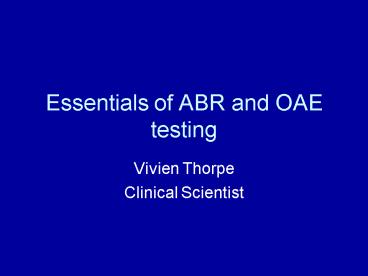Essentials of ABR and OAE testing - PowerPoint PPT Presentation
1 / 35
Title:
Essentials of ABR and OAE testing
Description:
Neural signal generated in the VIIIth cranial nerve and brainstem in response to ... Bone vibrator also used for bone conduction testing. ABR - Recording ... – PowerPoint PPT presentation
Number of Views:1885
Avg rating:3.0/5.0
Title: Essentials of ABR and OAE testing
1
Essentials of ABR and OAE testing
- Vivien Thorpe
- Clinical Scientist
2
Introduction
- Auditory Brainstem Response
- What is it?
- Stimuli
- Recording
- Uses
- Otoacoustic Emissions
- What are they?
- Stimuli
- Recording
- Uses
3
ABR What is it?
- Auditory Brainstem Response
- Neural signal generated in the VIIIth cranial
nerve and brainstem in response to an auditory
stimulus - Consists of a series of peaks and troughs
occurring in the 10ms after stimulus presentation - Recorded using surface electrodes on the scalp
4
ABR What is it?
70dBnHL
0.16µV/div, 1.5ms/div
5
ABR What is it?
- Wave I is the action potential in the distal
portion of the VIIIth nerve - Generators of other waves are less clear and
possibly a combination of different nuclei in the
brainstem - Relies on the integrity of the auditory system up
to the level of the brainstem - Not a test of hearing but has good correlation
with behavioural thresholds
6
ABR - Stimuli
- Most common stimulus is the broadband click
- Contains frequencies from 1 8kHz
- Can produce clear responses with large waveforms
- Lack of frequency specificity
- Better frequency specificity obtained with
tone-pip stimuli
7
ABR - Recording
- ABR recorded using surface electrodes
- Active High forehead or vertex
- Reference Ipsilateral mastoid
- Guard temple
- Stimulus delivered using headphones or insert
earphones for air conduction testing - Bone vibrator also used for bone conduction
testing
8
ABR - Recording
- ABR has a very small amplitude compared to
background EEG - Signal averaging used
- Response occurs at the same time after the
stimulus, noise is random - Add together lots of responses (approx. 2000)
- Noise cancels out but signal doesnt
- Good recording conditions required
- Still relaxed subject/sleeping baby
- Low electrical noise
9
ABR Uses
- Threshold estimation
- Accurate to within 15dB of behavioural
thresholds - For babies and other difficult-to-test subjects
- Suspected non-organic loss
10
ABR Threshold estimation
Subject 1
Normal thresholds
0.12µV/div, 2.0ms/div
11
ABR Threshold estimation
Subject 2
50dBnHL
30dBnHL
40dBnHL
Raised AC thresholds
0.12µV/div, 2.0ms/div
12
ABR Threshold estimation
Subject 2
38dBnHL
28dBnHL
Normal BC thresholds conductive loss
18dBnHL
0.12µV/div, 2.0ms/div
13
ABR Threshold estimation
Subject 3
60dBnHL
40dBnHL
50dBnHL
Raised AC thresholds
0.12µV/div, 2.0ms/div
14
ABR Threshold estimation
Subject 3
60dBnHL
50dBnHL
Raised AC thresholds
40dBnHL
30dBnHL
0.12µV/div, 2.0ms/div
15
ABR Threshold estimation
Subject 3
60dBnHL
50dBnHL
Raised AC thresholds
40dBnHL
0.12µV/div, 2.0ms/div
16
ABR Threshold estimation
Subject 3
57dBnHL
47dBnHL
Raised BC thresholds sensorineural loss
37dBnHL
0.12µV/div, 2.0ms/div
17
ABR Threshold estimation
Subject 4
85dBnHL
70dBnHL
Raised AC thresholds
50dBnHL
0.12µV/div, 2.0ms/div
18
ABR Threshold estimation
Subject 4
Raised BC thresholds sensorineural loss
67dBnHL
0.12µV/div, 2.0ms/div
19
ABR - Uses
- Otoneurological investigation
- To investigate retro-cochlear pathology e.g.
acoustic neuroma - Latency of waves compared to normative data
- Inter-peak intervals also assessed
20
ABR - Uses
21
Otoacoustic emissions
22
OAEs What are they?
- Normal cochlear function
- Outer hair cells change their length in response
to sound stimuli - Purpose is to increase cochlear frequency
discrimination - Causes vibrations in the middle ear and TM
- These can be recorded as OAEs in the ear canal
- Generated by OHCs
23
OAEs - Stimuli
- Approximately 60 of people generate OAEs
spontaneously but of limited clinical value - Two main types of evoked OAEs
- Transient evoked by a click stimulus
- Distortion product non-linear response to two
stimulus tones
24
OAEs - Stimuli
25
OAEs - Recording
- Recorded by placing a probe in the ear canal
- Provides stimulus (80dB)
- Records OAE response
- Recording requires
- Good probe fit
- Quiet environment
- Response only recordable with normal ear canal
and middle ear function
26
OAEs - Recording
27
OAEs - Recording
- Response usually displayed in frequency bands
- Signal strength compared to noise level
28
OAEs - Uses
- OAEs not a hearing test
- High correlation between sensory hearing loss and
OAE absence demonstrates that most sensory losses
involve OHC dysfunction - OHCs are vulnerable to noise, oxygen deprivation
and ototoxic agents - Robust OAEs normally present only if hearing
threshold 20dBHL (transient stimuli)
29
OAEs - Uses
- Universal Newborn Hearing Screening
- OAEs widely used in screening and many published
reports - In low risk new-born babies most hearing loss is
sensory (involves loss of OHCs) - Will be picked up by OAEs
- For babies at risk of IHC/neural dysfunction ABR
is required as well
30
OAEs - Uses
- General audiology
- Objective test
- Selectively tests OHC function
- Monitoring for ototoxicity
- Can monitor OHC function for effects of
ototoxicity - Common ototoxic agents with OHC effects include
Gentamycin and Cisplatin
31
OAEs - Uses
Subject 1
32
OAEs - Uses
Subject 1
- Possible non-organic loss
33
OAEs - Uses
- Subject 2
- CF patient treated with Tobramycin
34
OAEs - Uses
Subject 2
35
Questions?

